Research Article - (2020) Volume 8, Issue 2
Root yield response of pro-vitamin ‘A’ cassava was studied in Umudike for five years using climatic data collected from Agro-met Unit of the National Root Crops Research Institute, Umudike. Data on pertinent climatic parameter and their relationship with pro-vitamin ‘A’ cassava were analyzed using regression, correlation and descriptive statistics. The results reveal that all the seven climatic parameters possess upward trends with annual values of rainfall increasing at the rate of 2.455 mm annually, maximum temperature 0.029°C, minimum temperature 0.220°C, mean annual temperature 0.024°C, relative humidity 0.282%, sunshine hours 0.004 hrs and soil temperature 0.015°C. Correlating climatic indices with pro-vitamin ‘A’ cassava root yield, time, relative humidity and soil temperature were significant at 5% level of confidence, that is 61%, 60%, and 64% respectively while the relationship with maximum temperature were significant at 10% confidence level, that is 53%. Some other factors such as agronomic practices and nutrient content of the soil could have contributed to the root yield of pro-vitamin ‘A’ cassava in the study area. In conclusion, the variations in root yield of pro-vitamin ‘A’ cassava over the years studied in Umudike depend majorly on the values and trends of climatic parameters. Therefore, it is recommended, among others, that the variability, values, and trends of pertinent climatic parameters should be monitored constantly.
Pro-vitamin ‘A’ cassava; Trends; Climatic parameters; Root yield
Cassava is a major root crop in low and middle-income countries and it is the third-largest source of low-cost carbohydrate in the world with Africa being the largest center of production [1]. Cassava is a staple food for more than 800 million people worldwide and the main source of calories for over 500 million people across Africa, Latin America and Asia [2,3]. Nigeria is the largest producer of cassava in the world with about 45 million metric tonnes and its cassava transformation is the most advanced in Africa [4,5]. It is strategically valued for its role in food security, for example, 80% of the people eat cassava meal more than once a day while some large households take cassava meal daily throughout the year [6]. Indeed, cassava plays a major role in the country’s food security hence it is regarded as a crop with a high poverty reduction potential for Nigeria most especially as the cost of production is low [6,7]. Moreover, cassava has major advantages over other carbohydrate/ starch crops because of the variety of uses to which it can be put. It is available all year round, making it preferable to other more seasonal crops such as grains, peas and beans and other crops of food security [8]. The leaves may be consumed as a vegetable, or cooked as soup ingredient or dried and fed to livestock as a protein feed supplement. The stem is used for plant propagation, while the roots can be eaten directly either raw or boiled and can be processed into several products that can easily and safely be consumed or stored for human and industrial consumption. In addition to being a feed source, cassava is also used in the production of yeast, alcohol, and starch for various industrial purposes in the textile, plywood, paper and pharmaceutical industries [9].
Despite that cassava is a relatively cheap carbohydrate source capable of supplying adequate calories to human and livestock, it is poor nutritionally in terms of micronutrients, protein, vitamin and lacks the sulfur-containing amino acids such as methionine, lysine, and cysteine rendering the crop inferior to wheat and maize [10]. It is on account of this and in the bid to add value to cassava as a major food crop that a variety is known as pro-vitamin ‘A’ cassava was introduced. The pro-vitamins ‘A’ cassava variety is yellow in color and naturally rich in pro-vitamin ‘A’. Its variety with β-carotene concentration through natural plant breeding techniques was introduced into Africa by International Institute of Tropical Agriculture (IITA), Ibadan in collaboration with National Root Crops Research Institute (NRCRI), Umudike both in Nigeria [11].
Climate is a long term average condition that exercise either directly or indirectly controls or affects agricultural production. Successful agricultural cultivation depends on climate which varies in time and space. Because climate forms the major part of the physical environment in which agriculture thrives as it determines what choice of crop to cultivate, when and how to cultivate it and yield of the crop. Crop yield is the product of growth and development and that rainfall, atmospheric temperature, soil temperature, relative humidity, and sunshine hours provide a major constraint on primary productivity, which in turn determines secondary productivity [12]. For instance, cassava growth or failure can result if rain does not fall at all under rain-fed agriculture, or if it does not fall at the right time, or if it falls little. Water stress at any time in that early period reduces significantly the growth of roots and shoots and impairs subsequent development of the storage roots. Cassava can grow in areas that receive just 400 mm of average annual rainfall [13,14]. But higher yields have been obtained with much higher levels of water supply. Cassava shows different growth behavior and yield in different years as a result of differences in the annual weather conditions [15]. In India, it was also reported that differing growth of cassava in different seasons [16]. Annual conditions of rainfall, atmospheric and soil temperatures, relative humidity and sunshine hours influence the yield of cassava.
The production of pro-vitamin ‘A’ cassava is being carried out in Umudike which is a typical humid tropical area with soils that are generally fertile, and rich in clay and kaolin deposit. Therefore, cassava cultivation in the area is rain-fed, though there are minor rivers in Umudike that would have been harnessed if there were a need for irrigation. There is the need to examine the extent to which yield of pro-vitamin ‘A’ cassava responds to climatic parameters.
The study area is Umudike in Abia State, South-Eastern Nigeria (Figure 1). It is located at latitude 05ᵒ29’N and longitude 7ᵒ33’E, and altitude of 122 m. This makes the location a typical humid tropical region where annual rainfall total is about 2200 mm. Averagely, September is the month with the highest amount of rainfall while the month with the lowest amount is December. The air temperature ranges between 21.2°C and 33.6°C, and relative humidity of 60% to 83% [17].
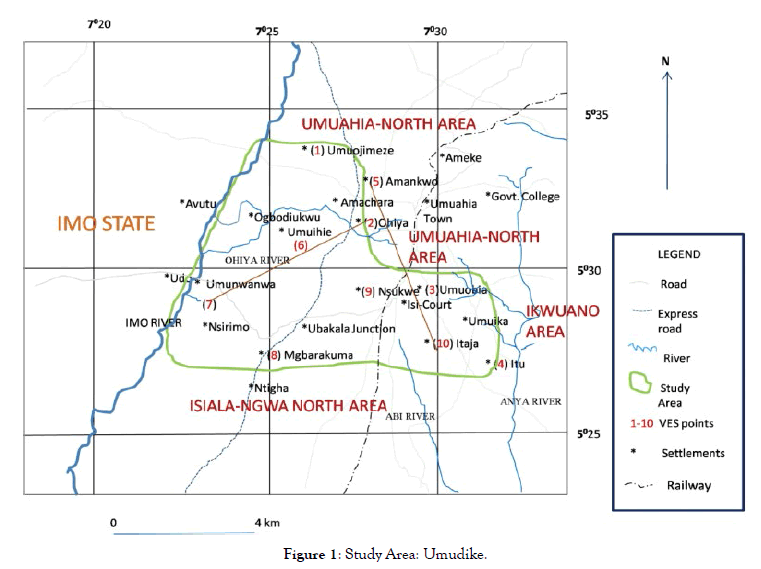
Figure 1: Study Area: Umudike.
Over 70% of the population is involved in agriculture and trading as occupations while the remaining 30% is into paid job [18]. Food crops majorly cultivated include cassava, yam, rice, plantain, and maize. Of these crops, cassava is the most popular in homes in Abia State owing to the several food forms that are produced from it such as garri (or eba), fufu (or akpu) and tapioca for man. Cassava is also processed into chips and pellets for livestock and fish.
Daily maximum and minimum temperatures of Umudike covering 33 years (from 1983 to 2015) were collected and transformed to mean monthly temperatures and to annual means for this study. As for rainfall data, monthly totals were transformed to mean annual total and so with soil temperature at 20 cm (20 cm was chosen because it is the average depth for cassava), relative humidity and sunshine hours. These climatic data were obtained from the Agromet Unit of National Root Crops Research Institute, Umudike. The data on tonnage of pro-vitamin ‘A’ cassava yield tons per hectare which cover five years (2011-2015) from the experimental farm of National Root Crops Research Institute, Umudike documentaries. The linear regression statistic was employed in modeling the trends of the climatic parameters while the correlation was used to ascertain the extent to which climatic parameters had influenced the yield of pro-vitamin ‘A’ cassava. In case of missing values (i.e. a year without and/or incomplete data) linear regression quantitative technique was used to determine the unknown values from the known values [19].
Table 1 shows the root yield of pro-vitamin ‘A’ cassava in Umudike (tons/h) over the years. Here there are variations in the root yield of pro-vitamin ‘A’ cassava in Umudike over the five years studied (2011-2015).
| Year | Pro vitamin A root yield (Tons per ha) | Annual rainfall total (mm) | Mean annual Relative humidity (%) | Mean annual maximum temperature (?C) | Mean annual minimum temperature (?C) | Mean annual temperature (?C) | Mean annual soil temperature (?C) | Mean annual sunshine hours (hrs) |
|---|---|---|---|---|---|---|---|---|
| 2011 | 51 | 2060.8 | 76 | 31.5 | 22.7 | 27.1 | 28.2 | 4.5 |
| 2012 | 53 | 2230.4 | 81 | 32.1 | 22.7 | 27.4 | 30 | 4.1 |
| 2013 | 48 | 2123.9 | 82 | 31.5 | 22.5 | 27 | 28 | 4.1 |
| 2014 | 38 | 1837.6 | 82 | 31.4 | 23.4 | 27.4 | 27.9 | 4.2 |
| 2015 | 41 | 2213 | 89 | 31.5 | 23.7 | 27.6 | 27.9 | 4.9 |
| Mean for the years | 46.2 | 2093.1 | 82 | 31.6 | 23 | 27.3 | 28.4 | 4.4 |
Table 1: Root yield of pro vitamin A cassava and climatic parameters in Umudike.
As shown in Table 1, the year 2012, recorded the highest root yield of 53 tons per hectare, followed by the year 2011 which had 51 tons/ha, while the year 2014 recorded the lowest yield of 38 tons per hectare, followed by 2015 with 41 tons/ha. There are variations in the root yield of pro-vitamin ‘A’ cassava across the study area. The considerable climatic variability observed within the study years, among other factors could have affected root yield response considerably, hence the observed fluctuations of the yield of pro-vitamin ‘A’ cassava across the five years [15]. It was confirmed that cassava shows different growth and yield behavior in different years as a result of differences in the annual weather conditions. Similarly, it was observed that crop yield varies from one season to another owing to variations to climate during the growing season [20-22]. Also, there is a link that shows reduced agricultural productivity and low income to the Nigerian farmers with fluctuations in moisture patterns. The scientist also emphasized that as much as 80% of the variability of agricultural production is due to the variability in climatic conditions [23].
An analysis of the annual rainfall total of the study area shows that 1998 is the year with the highest total of 2751.9 mm while 1985 has the lowest 1511.4 mm for the period studied (Figure 2). During the core study period between 2011 and 2015, the highest rainfall total was 2230.4 mm in the year 2012. It was in this 2012 that the highest root yield of pro-vitamin ‘A’ cassava was recorded (Table 2) while the year with the lowest rainfall 1837.6 mm, 2014 had the lowest yield. Employing the regression analysis, as shown in Figure 2, the annual rainfall totals are increasing at the rate of 2.455 mm per annum. In other words, the least square line possesses a positive slope. Many fluctuations were observed between 1983 and 2015 with notable peaks occurring in 1984, 1987 1990, 1998, 2001, 2004 and 2008.
| Time (year) | Max temp. (?C) | Min temp. (?C) | Mean temp. (?C) | Total rainfall (mm) | Sunshine Hour (hrs) |
Relative Humidity (%) |
Soil temp (?C) |
Root yield (ton/ha) | |
|---|---|---|---|---|---|---|---|---|---|
| Time (year) | 1 | ||||||||
| Max temp. (°C) | -0.39 | 1 | |||||||
| Min temp. (°C) | -0.08 | 0.85*** | 1 | ||||||
| Mean temp. (°C) | -0.20 | 0.93*** | 0.98*** | 1 | |||||
| Total rainfall (mm) | -0.09 | 0.60** | 0.30 | 0.39 | 1 | ||||
| Relative humidity (%) | 0.92*** | -0.36 | -0.62** | -0.55* | 0.26 | 1 | |||
| Sunshine hours (hrs) | 0.41 | -0.11 | 0.06 | -0.02 | 0.30 | 0.50* | 1 | ||
| Soil temp. (°C) | -0.47 | 0.99*** | 0.84*** | 0.93*** | 0.49* | -0.43 | -0.23 | 1 | |
| Root yield ton/ha) | -0.61** | 0.53* | 0.33 | 0.45 | -0.14 | -0.23 | -0.60** | 0.64** | 1 |
*, ** and *** means significant level at 10%, 5% and 1% respectively
Table 2: Correlation analysis of pro vitamin A cassava root yield and climatic indices.
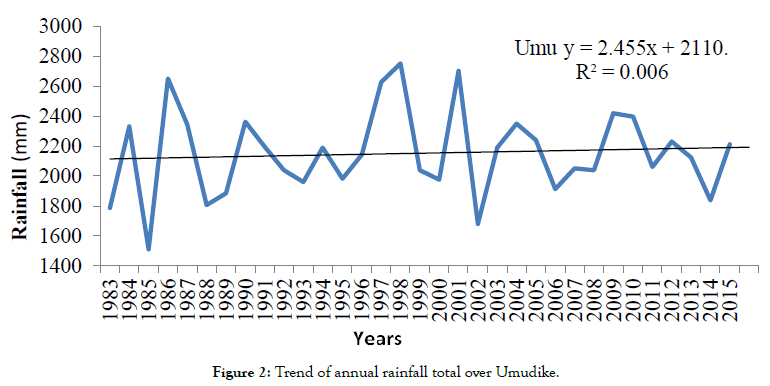
Figure 2: Trend of annual rainfall total over Umudike.
From the least square line, rainfall total across Umudike varies and possesses significant fluctuations, slopes, and depressions. The positive trend experienced in annual rainfall total over Umudike could be as a result of its location- nearness to the Atlantic Ocean [24,25]. The studies emphasized that rainfall distribution, whether annual, seasonal or daily is the most changeable of the weather parameter varying in distribution, duration, and intensity. In a related study, it was opined that recent flooding and precipitation events in the USA and worldwide have caused great damage to crop production [26]. The study emphasized that if the frequency of these weather extremes were to increase shortly, the cost of crop losses in the coming decades could rise dramatically.
The mean annual maximum temperature of Umudike for the study period has 2007 and 2012 as the years with the highest value of 32.1°C whereas 1995 had the lowest, 30.5°C (Figure 3).
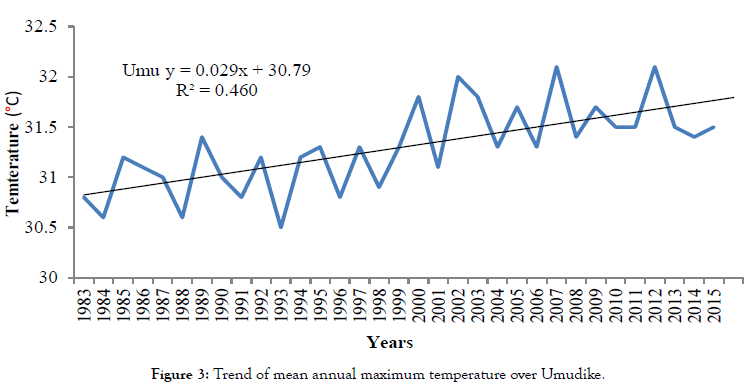
Figure 3: Trend of mean annual maximum temperature over Umudike.
Based on regression analysis, the mean annual maximum temperature of Umudike is increasing at the rate of 0.029°C per annum and thus possesses a positive slope (Figure 3). The peaks occurred in 2000, 2002, 2007 and 2012 (Figure 3).
On the other hand, the mean annual minimum temperature of Umudike for the period, 1983 to 2015 has 2000 and 2002 as the years with the highest value of 23.3°C whereas 1991 has the lowest, 21.7°C (Figure 4).
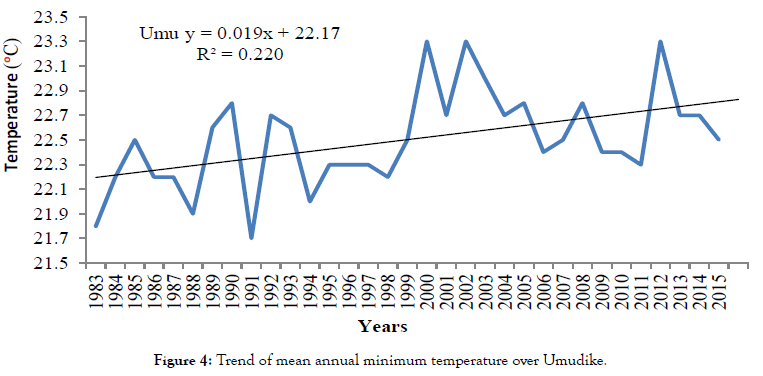
Figure 4: Trend of mean annual minimum temperature over Umudike.
An inspection of the trend analysis represented by the least square line reveals that the mean annual minimum temperature over Umudike possesses a positive slope. The minimum temperature is increasing at the rate of 0.019°C annually (Figure 4).
The annual mean temperature for Umudike, recorded its highest value of 27.7°C in the years 2002 and 2012, whereas 1983, 1988 and 1991 recorded the lowest value of 26.3°C for the period studied (Figure 5).
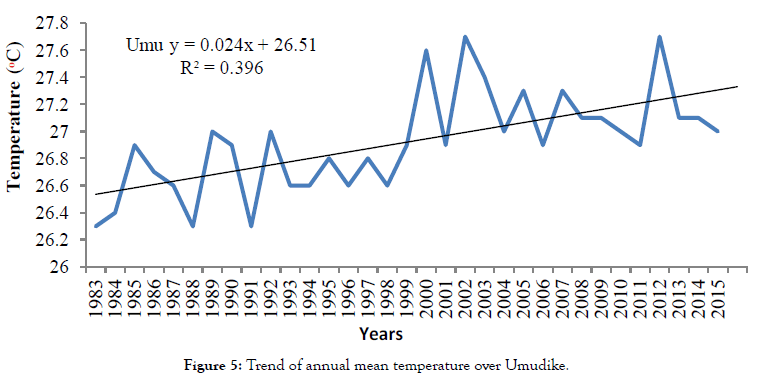
Figure 5: Trend of annual mean temperature over Umudike.
Employing the regression analysis as shown by the least square line, the annual mean temperature is increasing at the rate of 0.024°C per annum, and thus possesses a positive slope (Figure 5).
Air temperature is another parameter that affects the growth of the plant [16]. Air temperatures across Umudike from 1983 to 2015 are relatively high. It possesses slopes and consequently upward trends. By implication, the temperatures are increasing though the steepness of the slopes is not the same. This implies a warming trend for Umudike and this is in agreement with the global trend [27,28].
The highest relative humidity value of Umudike, 89% was in 2015 whereas the lowest value of 73% was recorded in 1983, 1984 and 1985 for the year studied (33 years) (Figure 6). During the core study period between 2011 and 2015, the year with the highest relative humidity value was 2015 with a value of 89% and 2011 year had the lowest value of 76% (Figure 6).
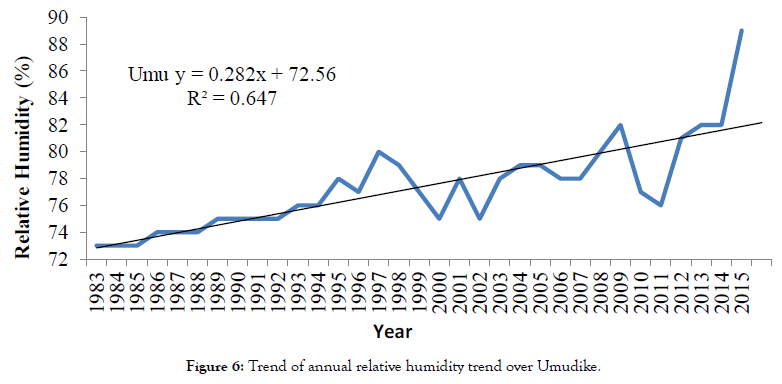
Figure 6: Trend of annual relative humidity trend over Umudike.
The relative humidity rate is increasing at the rate of 0.282% per annum, and consequently upward trend with the implication of increasing water molecules in the earth’s atmosphere (Figure 6). This attribute could be as a result of wet surfaces that exist in the area as water vapor in the atmosphere comes through evaporation from the oceans, lakes, rivers, ice-fields and glaciers, through transpiration from plants and respiration from animals because ordinarily, the more the water molecules in the atmosphere the more the tendency for the cloud to form and by extension precipitation. This finding is significantly related to previous studies [29]. They reported that three potatoes (Solarium tuberosum L.) cultivars grown at high RH (85%) produced increased tuber yields compared to plants grown at lower RH (50%), while the leaf area was greater at the lower RH level. Crop plants, including lettuce (Lactuca sativa L.), wheat. (Triticum aestivum L.), sugar beet (Beta vulgaris L.), and kale (Brassica oleracea L.) have all responded positively to increased relative humidity should be positively related to crop production [30,31]. The basis for this assumption is that crops tend to absorb soil nutrients for optimum yield when there is sufficient humid air [32].
From 1983 to 2015, Umudike had the highest value of sunshine hours in the year 2003 with a value of 5.2 hours whereas the lowest value of 3.3 hours was recorded in the year 1992 (Figure 7).
The sunshine hours for the study area are increasing by 0.004 hrs per annum (Figure 7). The trend is therefore upward. Sunshine hours for Umudike possess a positive slope, increasing at 0.004 hrs per annum. Sunshine determines photosynthesis; the more the hours of it the more photosynthesis will take place [33]. An upward trend in sunshine hours could, therefore, imply better root yield response of pro-vitamin ‘A’ cassava in years ahead.
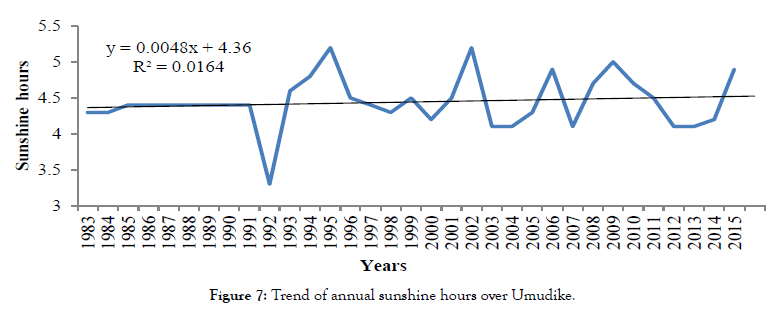
Figure 7: Trend of annual sunshine hours over Umudike.
In Umudike, the year 2012 had the highest value of 30°C for soil temperature whereas the lowest soil temperature value was in the years 2014 and 2015 with 27.9°C value within the core 5 years of study from 2011-2015 (Figure 8 and Table 1). Similarly, 2012 recorded the highest yield of 53 tons per hectare while 2014 had the lowest yield of 38 tons per hectare.
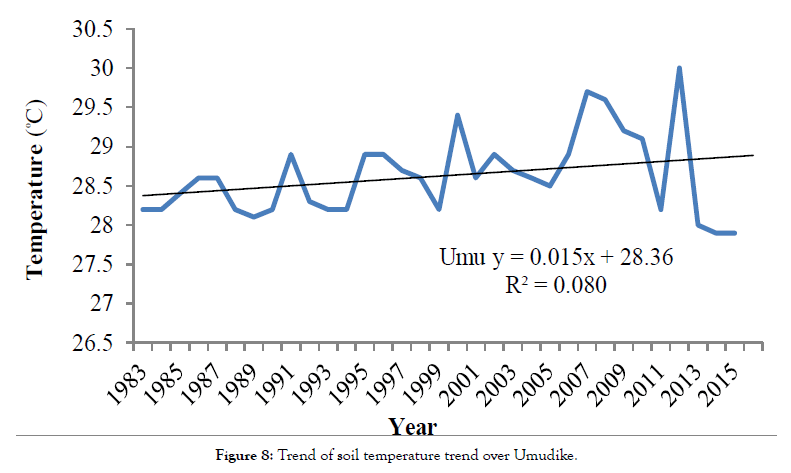
Figure 8: Trend of soil temperature trend over Umudike.
A close examination of the annual soil temperature trend line in (Figure 8) reveals that Umudike possesses a positive slope. It is increasing by 0.015°C annually. Soil temperature being atmospheric temperature-dependent, also has rainfall as its moderator because rainfall brings increased moisture in the soil and this moisture moderates the temperature of the soil. The positive trends in the soil temperature of Umudike could be associated with positive trends in air temperature. A high correlation between temporal changes in soil temperature and those of air temperature was indicated [34]. The warming rate of 0.015°C per annum of soil temperature could have been higher in line with air temperature values of 0.029°C but for rainfall which possesses an upward trend, implying more soil moisture. Since water in the soil acts as a coolant, thus more of it in the soil would bring about more cooling implying a reduction in soil temperature. However, the rainfall increase is gradual though steady thus making its moderating effect not to be overwhelming especially, as the air temperature, a major factor in soil warming, is also increasing. Increase in soil temperature enhanced cucumber yield by about 50% [35]. Cassava has been reported to grow best at a soil temperature of about 30°C [36]. Soil temperature in Umudike hovers around 28.4°C on average (Figure 8 and Table 2) and with an upward trend thus implying a steady and better environment for improvement in cassava yield in the area [37]. While the increase in soil temperature will increase the yield of provitamin ‘A’ cassava, a decrease in it could bring about a decrease in pro-vitamin ‘A’ cassava during germination. It was observed that soil temperature is a predictor variable, which determines cassava emergence, growth, and yield [38,39].
When yield was correlated against the seven climatic parameters, (Table 2) emerged.
In Table 2, the result of the correlation analysis of the pro-vitamin ‘A’ cassava yield and climatic indices/parameters showed that the individual relationships between root yield and time, relative humidity and soil temperature were significant at 5% level of confidence (p<0.05), that is 61%, 60%, and 64% respectively. Significance also occurred in the correlation between maximum temperature and root yield of pro-vitamin ‘A’ cassava but at a 10% level of confidence, which is 53%. The relationships between root yield and minimum temperature, mean temperature, total rainfall and sunshine hours were not significant at all the levels of confidence. This implies that as time (years), relative humidity and soil temperature increased, pro-vitamin ‘A’ cassava root yield also increased at 5% confidence level. The yield also increased with increasing maximum temperature at 10% confidence level. However, those indices whose relationships with the root yield were not significant do not imply that they did not contribute to the yield. They did, but very little.
On the other hand, any increase in the values of -0.14, -0.60 and -0.23 for rainfall, relative humidity and sunshine hours respectively could bring about a decrease in the yield of pro-vitamin ‘A’ cassava in an area like Umudike because it is a typical humid tropical area where ordinarily rainfall, relative humidity and sunshine hours are high. An increase in rainfall and relative humidity in the study area could decrease yield through flooding and root rot. Excessive rainfall results in flooding, eroding of farmland, water-logged soil, plant roots to rot and damage to the tender young plants [27,40].
The result shows that the root yield of pro-vitamin ‘A’ cassava in Umudike is not the same, it varied with years depending majorly on the amounts and trends of climatic parameters. For example, the year 2012 recorded the highest yield of 53 metric tons while 2014 had the least yield of 38 metric tons probably following the annual rainfall totals for the years, 2230.4 mm and 1837.6 mm respectively. Whereas the increase in soil temperature would increase root yield of pro-vitamin ‘A’ cassava as found in the study, a decrease in soil temperature could bring about a decrease in provitamin ‘A’ cassava root yield. This confirmed that there are annual significant variations in the yield of pro-vitamin ‘A’ cassava across Umudike following variations in rainfall, soil temperature, and other climatic parameters. Increased rainfall without flooding may be beneficial for the yield of pro-vitamin ‘A’ cassava. Conversely, excessive rainfall could cause a decrease in the yield because of resultant flooding.
The study, therefore, recommends that there should be steady monitoring of pertinent climatic parameters with special regard to their variability, values, and trends. Farmers should be encouraged to apply fertilizer and other agro-chemicals to improve soil fertility to boost the high yield of pro-vitamin ‘A’ cassava to help tackle food insecurity and alleviate poverty. Also, more awareness of the adoption of modern agricultural techniques to boost crop yield should be created among farmers. Finally, this variety of cassava is new and so, farmers should be encouraged to adopt it especially because of its tremendous health benefits and it’s resistant to pests and diseases.
Citation: Okoye NN, Nwagbara MO, Ijioma MA (2020) Root Yield Response of Pro-Vitamin ‘A’ Cassava to Climatic Parameters in Umudike, Southeastern Nigeria. J Climatol Weather Forecast 8:253. doi: 10.35248/2332-2594.2020.8.253
Received: 14-Jan-2020 Published: 22-Apr-2020, DOI: 10.35248/2332-2594.2020.8.253
Copyright: © 2020 Okoye NN, et al. This is an open-access article distributed under the terms of the Creative Commons Attribution License, which permits unrestricted use, distribution, and reproduction in any medium, provided the original author and source are credited.